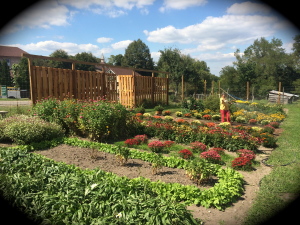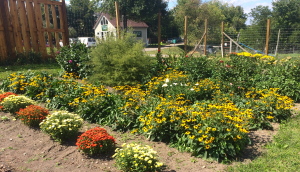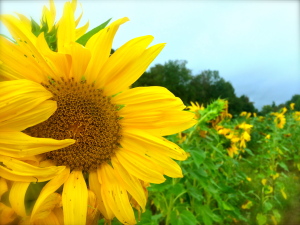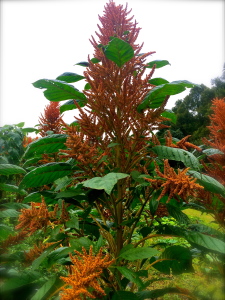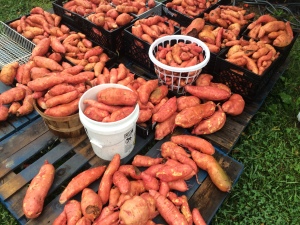Greetings from the New Vrindaban Gardens: Harvest & Changing Seasons
The late summer has brought us a bounty of vegetables and a mountain of work preparing for the fall. The teaching garden is filled with fall colors as the mums, calendula, daisies, and lilies have begun to bloom. As the summer flowers and vegetables have completed their season the beds containing annual flowers (one that do not grow back in the spring) are being cover cropped. In the photo above daikon radishes are growing around daises yet to bloom. Other cover crops in the teaching garden include vicia vilosa (winter legume), wheat, and rye.
In the Garden of Seven Gates it has been all about harvesting, building, and planting. Yes, I said planting; this time of year it is difficult to keep up the same early summer pace in the garden. Weeds start to win the epic battle with the garden, some plants start to struggle, and just keeping up with the harvest in a daunting task all its own. However, to really get the most of your garden don’t miss out on the often forgotten benefits of fall planting. In early August we seeded cabbage, spinach, lettuce, radishes, and beets which all love the fall weather and are fairly quick to harvest (none more than 60 days). At the end of August we seeded for our winter greens high tunnel with many of the same crops and added kale. The buckwheat field is now filled with an infinity of beautiful radish greens. In the terraces where vegetables like tomatoes and sweet potatoes were growing it is now cover cropped for the fall and will return early in the spring. For weeks we had beautiful fields of giant sunflowers, the seeds are now drying to be shared with the community. Their former home is now a field of rye.
With more green beans to come, squash harvest, greens, and amaranth we still have a lot of picking to do. The test plot of giant golden amaranth has proven not only to be sustainable (no irrigation, no fertilizer, no pesticides), beautiful (most plants are over 9 feet tall filled with seeds) it produced an incredible bumper crop of amazing gluten free complete grains. Which will be harvested after the first frost.
Another exciting harvest this year was sweet potatoes. This is a crop I suggest for everyone that can create some form of raised bed in their garden. When planted under the right conditions a single plant slip yields 8-10 lbs of sweet potatoes. We had enough to set up a “grown on site” sweet potato fry booth at the Festival of Colors. We had a wonderful response and were very excited to share our harvest with people from many different communities.
As the New Vrindaban gardens transition to fall I will leave you with a quote from Rose G. Kingsley….. “In the garden, Autumn is, indeed the crowning glory of the year, bringing us the fruition of months of thought and care and toil. And at no season, safe perhaps in Daffodil time, do we get such superb colour effects as from August to November.” The Autumn Garden 1905
